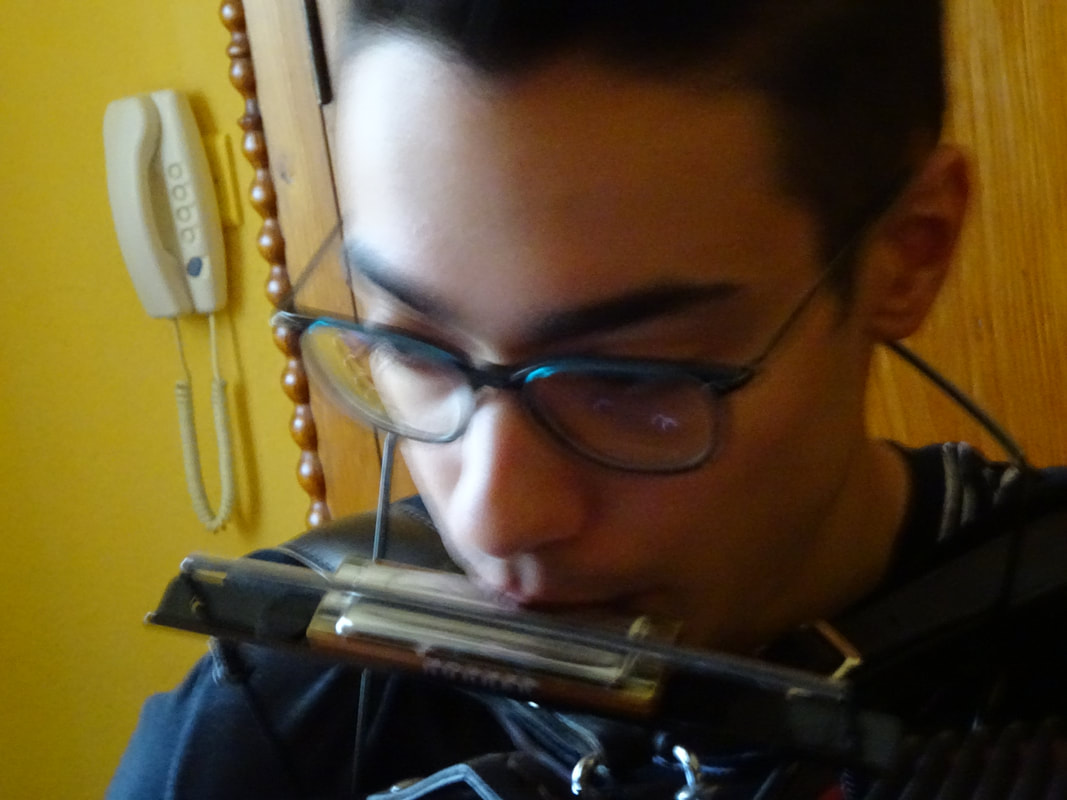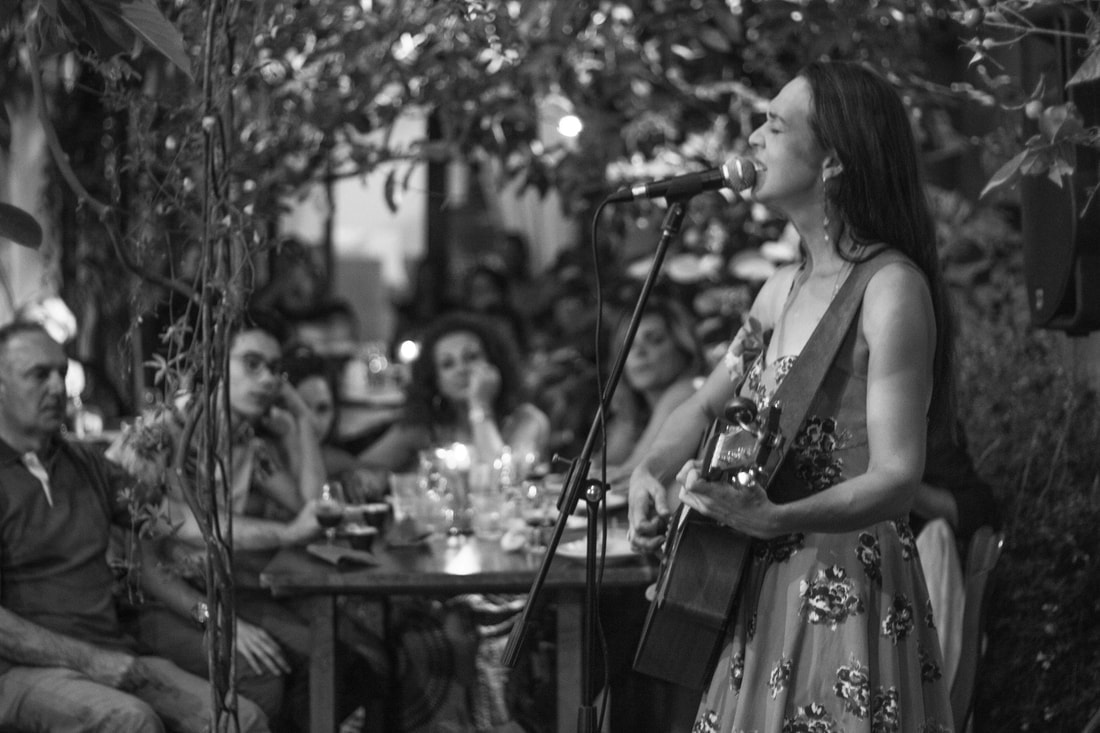One of the things that fascinates me most about the mountain village of Santu Lussurgiu, Sardinia (Italy) is how sounds and images of Americanness circulate. From Marilyn Monroe and Audrey Hepburn posters in all the local bars, to a layered strawberry pastry sold in those bars called “l’Americana,” to performances by Sardinian musicians of “Cotton Eyed Joe” on the village piazza on Saturday night, strategic threads of “l’America,” mostly from times past, are everywhere. There is even a phrase in the village, “America zichi” [American wealth] which refers to the ability of Sardinians who emigrated to “l’America” (both north and south) who were able to stop eating orzo—a less nutritious grain—and begin eating the coveted and more life-sustaining wheat grown in America.
Then, two weeks ago, I released a video with a young accordion player from Santu Lussurgiu of a song we wrote with his relative Giuseppe Scano, “Il Paese dei Brividi” (The Place that Gives You Goosebumps”) as an homage to the beauty and sense of welcome that I and so many other outsiders experience upon entering it for the first time. Crucially, however, the song is written from their perspective, emphasizing the things they hope might first be noticed and appreciated in the village, thus giving me key insights into how they themselves see the village of their birth. In the song, I sing and play rhythm guitar, and the accordion player Matteo Scano plays a blues-inflected harmonica introduction and then lets loose with beautiful, cascading harmonica “fills” and solos throughout the rest of the song. The song itself was inspired by two Sardinian melodies, one a Sardinian ballad called “passu torrau” recalled in the chorus, and the other from the Catholic liturgy sung in Sardo, “Deus ti Salvet Maria”, which we then modified, ran with, and made our own.
Then, two weeks ago, I released a video with a young accordion player from Santu Lussurgiu of a song we wrote with his relative Giuseppe Scano, “Il Paese dei Brividi” (The Place that Gives You Goosebumps”) as an homage to the beauty and sense of welcome that I and so many other outsiders experience upon entering it for the first time. Crucially, however, the song is written from their perspective, emphasizing the things they hope might first be noticed and appreciated in the village, thus giving me key insights into how they themselves see the village of their birth. In the song, I sing and play rhythm guitar, and the accordion player Matteo Scano plays a blues-inflected harmonica introduction and then lets loose with beautiful, cascading harmonica “fills” and solos throughout the rest of the song. The song itself was inspired by two Sardinian melodies, one a Sardinian ballad called “passu torrau” recalled in the chorus, and the other from the Catholic liturgy sung in Sardo, “Deus ti Salvet Maria”, which we then modified, ran with, and made our own.
For the video, Matteo suggested we film it in what he saw as the most iconic and representative places in the village, including in the businesses and “laboratories” where they make traditional cheese, a paper-thin bread called “carta di musica” (trans. “music paper,” similar to Piki bread), a well-known distillery, under historic stone arches used as bandit hideouts, and at the spring-fed drinking fountains spread throughout the village.
And so, equipped with a video camera, a microphone stand, and the assistance of our videographer, we set out across the cobblestone streets of Santu Lussurgiu (Santu Lussurzu in Sardo), humidity rising every second, to play our song live in each location for all who happened to walk by and listen. Then, under a giant stone arch, “L’Arco della Marmora,” we met Franzisco, retired sheepherder and cantu a cuncordu singer, who listened to our performance, clapped effusively at the end, then turned me and said, “Dai, facciamo un’Americanata”/Let’s do a song in the American style!” Game, but confused about what that might mean, I said ok, and he suggested we do a song in the key of “Re” (A major). And then, in a plaintive voice, he started singing “Oh Susanna” in Italian! I then sung him the version I know in English (“Oh Susanna/Don’t You Cry for Me/’Cus I’m Gone to Louisiana with a Banjo on My Knee”). He then turned to Matteo, and asked if they could try a portion of a “Ballo Sardo” (Sardinian ballad in the style of the village), and off they went again, Franzisco this time singing in a much fuller, more nasalized singing style complete with ornamentations, Matteo accompanying him on the accordion. It was a moment of complete time capsule, as we stood by this historic arch use to fend off marauders, Franzisco singing, Matteo playing accordion, the sound bouncing off stone walls in the narrow alley.
 The author with Franzisco Deriu, Santu Lussurgiu. Photo by Michela Scano, copyright 2018.
The author with Franzisco Deriu, Santu Lussurgiu. Photo by Michela Scano, copyright 2018.
And this, from my beginner’s perch, is how Americanness circulates in one small Sardinian “paese,” where one expressive form leads to another which leads to another, and song becomes a cascade of stories, and connections, and memories. Where a Sardinian-inflected song written by two Sardinians and an American inspires an “Americanata,” in this case the song “Oh Susanna,” which leads to a “ballo sardo” in the key of Re, sung by Franzisco and accompanied by Matteo. And so the Americanata-the American song--leads us back to the Sardinian song, Sardinian roots, sung in the Sardinian language (in this case, Lussorzesu).
Thus, our song about “Un’Americana In Paese” becomes a micro-ethnography in one small Sardinian village of how Sardi negotiate American presences in their worlds, how they see outsiders and self/other, and the things they see and value in American culture and in their own. This, in turn, also gives insight into how Giuseppe and Matteo also see their own village, i.e. the things that to them “make” the place and that others, on coming in, should see first or understand. This, I am given new ethnographic eyes into this place I am coming to love.
Perhaps, in the end, “Il Paese dei Brividi” as a genre of music is what Italian journalist Cinzia Meroni in an article she wrote for the newspaper L’Unione Sarda, terms “Country Sardo-Americana” (Sardinian American country), a genre that fuses, blends, and ultimately reinforces what it means to be Sardo and from the village of Santu Lussurzu.
Thus, our song about “Un’Americana In Paese” becomes a micro-ethnography in one small Sardinian village of how Sardi negotiate American presences in their worlds, how they see outsiders and self/other, and the things they see and value in American culture and in their own. This, in turn, also gives insight into how Giuseppe and Matteo also see their own village, i.e. the things that to them “make” the place and that others, on coming in, should see first or understand. This, I am given new ethnographic eyes into this place I am coming to love.
Perhaps, in the end, “Il Paese dei Brividi” as a genre of music is what Italian journalist Cinzia Meroni in an article she wrote for the newspaper L’Unione Sarda, terms “Country Sardo-Americana” (Sardinian American country), a genre that fuses, blends, and ultimately reinforces what it means to be Sardo and from the village of Santu Lussurzu.
Acknowledgements/Grazie Mille:
Thank you to: Matteo Scano for songwriting, videography, sound engineering, the idea to make the video, and overall for being such a joy to write a song with; to cowriter Giuseppe Scano, to Michela Scano for videography and photography, to Giampaolo Mura and the Distillery of Carlo Pische for permission to include footage of them in the video and in this blog. Thank you also to Giacomo Spanu, Franceso Deriu, Marco Lutzu and the children Emanuele, Antonio and Gabriele for permission to include the playing in the streets of Santu Lussurgiu.
Thank you to: Matteo Scano for songwriting, videography, sound engineering, the idea to make the video, and overall for being such a joy to write a song with; to cowriter Giuseppe Scano, to Michela Scano for videography and photography, to Giampaolo Mura and the Distillery of Carlo Pische for permission to include footage of them in the video and in this blog. Thank you also to Giacomo Spanu, Franceso Deriu, Marco Lutzu and the children Emanuele, Antonio and Gabriele for permission to include the playing in the streets of Santu Lussurgiu.













 RSS Feed
RSS Feed
